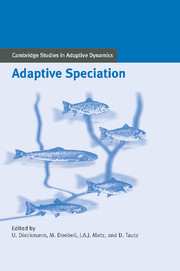Book contents
- Frontmatter
- Contents
- Contributing Authors
- Acknowledgments
- Notational Standards
- 1 Introduction
- 2 Speciation in Historical Perspective
- A Theories of Speciation
- B Ecological Mechanisms of Speciation
- 8 Speciation and Radiation in African Haplochromine Cichlids
- 9 Natural Selection and Ecological Speciation in Sticklebacks
- 10 Adaptive Speciation in Northern Freshwater Fishes
- 11 Sympatric Speciation in Insects
- 12 Adaptive Speciation in Agricultural Pests
- 13 Ecological Speciation in Flowering Plants
- 14 Experiments on Adaptation and Divergence in Bacterial Populations
- C Patterns of Speciation
- References
- Index
11 - Sympatric Speciation in Insects
Published online by Cambridge University Press: 05 July 2014
- Frontmatter
- Contents
- Contributing Authors
- Acknowledgments
- Notational Standards
- 1 Introduction
- 2 Speciation in Historical Perspective
- A Theories of Speciation
- B Ecological Mechanisms of Speciation
- 8 Speciation and Radiation in African Haplochromine Cichlids
- 9 Natural Selection and Ecological Speciation in Sticklebacks
- 10 Adaptive Speciation in Northern Freshwater Fishes
- 11 Sympatric Speciation in Insects
- 12 Adaptive Speciation in Agricultural Pests
- 13 Ecological Speciation in Flowering Plants
- 14 Experiments on Adaptation and Divergence in Bacterial Populations
- C Patterns of Speciation
- References
- Index
Summary
Insect Diversity, Body Size, Specialization, and Speciation
Insects are among the most abundant multicellular organisms on earth. Sampling in the tropics and subtropics suggests that there are 10 to 30 million species of insects (Erwin 1982). As a group, invertebrate insects, therefore, represent an inordinately large percentage of the world's fauna, far outnumbering their larger and more conspicuous vertebrate cousins, such as fish (about 24000), amphibians (about 4000), reptiles (7907), birds (9808), and mammals (4629). In fact, the number of species in many families of Heteroptera, Diptera, Coleoptera, and Hymenoptera outnumber the species in most classes of vertebrates.
Why are there so many insect species? One apparent reason is body size (Bush 1993). Their small size allows insects to subdivide habitats and specialize on resources that large animals are unable to exploit. Frequently, much of the life cycle occurs exclusively on the resource, which is particularly important since it induces assortative mating. Specialization permits a habitat occupied by a single vertebrate species to support a much greater number of small, often closely related, invertebrate species that can coexist in close sympatry with minimal competition. Vertebrate sister species usually have similar ecological needs, and are seldom sympatric because they competitively exclude one another. In contrast, it is estimated that the majority of insects, over 70% of which either feed on plants or are parasites and parasitoids, are highly host specific (Jaenike 1990). Sister species may sometimes even feed on different parts of the same host.
- Type
- Chapter
- Information
- Adaptive Speciation , pp. 229 - 248Publisher: Cambridge University PressPrint publication year: 2004
- 40
- Cited by

